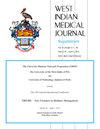The Case of Squamous Cell Carcinoma Accompanied Leukemoid Reaction.
IF 0.3
4区 医学
Q4 MEDICINE, GENERAL & INTERNAL
引用次数: 1
Abstract
Leukemoid reaction is characterized by an elevation in neutrophil levels in peripheral blood and is defined as a total leukocyte number exceeding 50,000/mm 3 . An increase in mature neutrophils occurs in peripheral blood in Leukemoid reaction. A 70-year-old man was referred to us due to development of leukocytosis. His history revealed that the mass had begun beneath the armpit 2 months previously and had spread rapidly. At physical examination his general condition was poor, and he was conscious, oriented and cooperative. Yellow-colored, painful, ulcerated and necrotized masses with discharge, attached to the skin and approximately 16x13 cm in size were determined in the left axilla. A painful, ulcerated, hemorrhagic mass with discharge attached to the skin and appearing to begin beneath the ear lobe, 10x9 cm in size, was determined below the ear. White cell count was 100,000 mm 3 . Ninety percent segmented neutrophils, 6% non-segmented neutrophils, 1.1% lymphocytes, 2.3% monocytes, 0.2% basophils and 0.3% eosinophils were determined at peripheral smear. Leukocyte alkaline phosphatase score was high. Squamous cell carcinoma with paraneoplastic Leukemoid reaction is an exceedingly rare combination. This case report was intended to remind physicians of the condition.鳞状细胞癌伴白血病反应1例。
白细胞样反应的特征是外周血中性粒细胞水平升高,定义为白细胞总数超过50000/mm3。在类白血病反应中,外周血中成熟中性粒细胞增多。一位70岁的老人由于白细胞增多而被转诊到我们这里。他的病史显示,肿块在两个月前就开始在腋下,并迅速扩散。在体检时,他的总体状况很差,而且他有意识、有方向感和合作精神。在左腋下发现黄色、疼痛、溃疡和坏死的肿块,伴有分泌物,附着在皮肤上,大小约16x13cm。在耳朵下方发现了一个疼痛、溃疡、出血的肿块,其分泌物附着在皮肤上,似乎始于耳垂下方,大小为10x9厘米。白细胞计数为100000毫米3。外周涂片中检测到90%的分段中性粒细胞、6%的非分段中性粒病毒、1.1%的淋巴细胞、2.3%的单核细胞、0.2%的嗜碱性粒细胞和0.3%的嗜酸性粒细胞。白细胞碱性磷酸酶评分高。鳞状细胞癌伴副肿瘤性白血病反应是一种极为罕见的组合。本病例报告旨在提醒医生注意这种情况。
本文章由计算机程序翻译,如有差异,请以英文原文为准。
求助全文
约1分钟内获得全文
求助全文
来源期刊

West Indian Medical Journal
医学-医学:内科
CiteScore
0.20
自引率
0.00%
发文量
0
审稿时长
4-8 weeks
期刊介绍:
The Journal is international in scope, with author and editorial contributions from across the globe. The focus is on clinical and epidemiological aspects of tropical and infectious diseases, new and re-emerging infections, chronic non-communicable diseases, and medical conditions prevalent in the Latin America-Caribbean region, and of significance to global health, especially in developing countries. The Journal covers all medical disciplines, as well as basic and translational research elucidating the pathophysiologic basis of diseases or focussing on new therapeutic approaches, and publishes original scientific research, reviews, case reports, brief communications, letters, commentaries and medical images. The Journal publishes four to six issues and four supplements annually. English is the language of publication but Abstracts are also duplicated in Spanish. Most of the articles are submitted at the authors’ initiative, but some are solicited by the Editor-in-Chief. Unless expressly stated, the Editorial Board does not accept responsibility for authors’ opinions.
All papers on submission are reviewed by a subcommittee. Those deemed worthy for review are sent to two or three reviewers (one of the three might be a statistician if necessary). The returned papers with reviewer comments are reviewed by the Editor-in-Chief. Papers may be rejected, accepted or sent back to authors for revision. Resubmitted papers from authors are reviewed by the Editor-in-Chief and may be sent back to reviewers or a final decision made by Editor-in-Chief. The decision of the Editorial Board is final with regards to rejected articles. Rejected articles will not be returned to the authors. The editorial subcommittee has the right to return sub-standard manuscripts to the authors, rather than passing them on to the reviewers. This implies outright rejection of the manuscript.
 求助内容:
求助内容: 应助结果提醒方式:
应助结果提醒方式:


